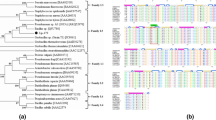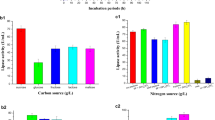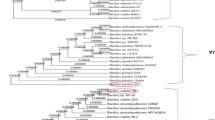Abstract
Two novel lipase genes (lipJ02, lipJ03) were isolated directly from environmental DNA via genome-walking method. Lipase gene lipJ02 contained an open reading frame (ORF) of 1,425 bp and encoded a 474-amino acids lipase protein, while lipase gene lipJ03 contained an ORF of 1,413 bp and encoded a 470-amino acids lipase protein. The lipase genes were cloned into expression vector pPIC9K and successfully integrated into a heterologous fungal host, Pichia pastoris KM71, and the recombinant P. pastoris were screened via a high-throughput method. The recombinants were induced by methanol to secrete active lipases into cultural medium. The recombinant lipases were also purified and characterized. The optimum temperature for the purified lipase LipJ02 and LipJ03 was 30 and 35°C, respectively, at pH 8.0. They exhibited similar thermostability, but LipJ02 exhibited better pH stability than LipJ03.



Similar content being viewed by others
References
Abelson JN, Simon MI, Deutscher MP (1990) Guide to protein purification. In: Methods in enzymology, vol. 182. Academic Press, San Diego, CA
Altschul SF, Madden TL, Schaffer AA, Zhang J, Zhang Z, Miller W, Lipman DJ (1997) Gapped BLAST and PSI-BLAST: a new generation of protein database search programs. Nucleic Acids Res 25:3389–3402
Amada K, Haruki M, Imanaka T, Morikawa M, Kanaya S (2000) Overproduction in Escherichia coli, purification and characterization of a family I.3 lipase from Pseudomonas sp. MIS38. Biochim Biophys Acta 1478(2):201–210
Amann RI, Ludwig W, Schleifer KH (1995) Phylogenetic identification and in situ detection of individual microbial cells without cultivation. Microbiol Rev 59:143–169
Beven CA, Dieckelmann M, Beacham IR (2001) A strain of Pseudomonas fluorescens with two lipase-encoding genes, one of which possibly encodes cytoplasmic lipolytic activity. J Appl Microbiol 90(6):979–987
Chung GH, Lee YP, Jeohn GH, Yoo OJ, Rhee JS (1991) Cloning and nucleotide sequence of thermostable lipase gene from Pseudomonas fluorescens. Agric Biol Chem 55:2359–2365
Cottrell MT, Moore JA, Kirchman DL (1999) Chitinases from uncultured marine microorganisms. Appl Environ Microbiol 65:2553–2557
Cottrell MT, Wood D, Yu L, Kirchman DL (2000) Selected chitinase genes in cultured and uncultured marine bacteria in the α- and γ- subclasses of the proteobacteria. Appl Environ Microbiol 66(3):1195–1201
Dharmsthiti S, Kuhasuntisuk B (1999) Lipase from Pseudomonas aeruginosa LP602: biochemical properties and application for wastewater treatment. J Ind Microbiol Biotech 21:75–80
Fojan P, Jonson PH, Petersen MTN, Petersen SB (2000) What distinguishes an esterase from a lipase: a novel structural approach. Biochimie 82:1033–1041
Henne A, Daniel R, Schmitz RA, Gottschalk G (1999) Construction of environmental DNA libraries in Escherichia coli and screening for the presence of genes conferring utilization of 4-hydroxybutyrate. Appl Environ Microbiol 65:3901–3907
Henne A, Schmitz RA, Bömeke M, Gottschalk G, Daniel R (2000) Screening of environmental DNA libraries for the presence of genes conferring lipolytic activity on Escherichia coli. Appl Environ Microbiol 66:3113–3116
Invitrogen. A manual of methods for expression of recombinant proteins in Pichia pastoris. Invitrogen Corporation. Catalog No. K1710-01
Jaeger K-E, Dijstra BW, Reetz MT (1999) Bacterial biocatalyst: molecular biology, three-dimensional structures, and biotechnological applications of lipases. Annu Rev Microbiol 56:315–351
Kojima Y, Kobayashi M, Shimizu S (2003) A novel lipase from Pseudomonas fluorescens HU380: gene cloning, overproduction, renaturation–activation, two-step purification, and characterization. J Biosci Bioeng 96:242–249
Kouker G, Jaeger K-E (1987) Specific and sensitive plate assay for bacterial lipase. Appl Environ Microbiol 53:211–213
Martinez A, Soberon-Chavez G (2001) Characterization of the lipA gene encoding the major lipase from Pseudomonas aeruginosa strain IGB83. Appl Microbiol Biotechnol 56:731–735
Matsumoto T, Ito M, Fukuda H, Kondo A (2004) Enantioselective transesterification using lipase-displaying yeast whole-cell biocatalyst. Appl Microbiol Biotechnol 64:481–485
Maurich V, Zacchigna M (1991) p-Nitrophenyl laurate: a substrate for the high-performance liquid chromatographic determination of lipase activity. J Chromatogr 566:453–459
Morris DD, Gibbs MD, Chin CWJ, Koh M-H, Wong KKY, Allison RW, Nelson PJ, Bergquist PL (1998) Cloning of the xynB gene from Dictyoglomus thermophilum Rt46B.1 and action of the gene product on Kraft pulp. Appl Environ Microbiol 64(5):1759–1765
Oh B, Kim H, Lee J, Kang S, Oh T (1999) Staphylococcus haemolyticus lipase: biochemical properties, substrate specificity and gene cloning. FEMS Microbiol Lett 179(2):385–392
Prim N, Blanco A, Martı'nez J, Pastor FIJ, Diaz P (2000) estA, a gene coding for a cell-bound esterase from Paenibacillus sp. BP-23, is a new member of the bacterial subclass of type B carboxylesterases. Res Microbiol 151:303–312
Rahman RNZA, Chin JH, Salleh AB (2003) Cloning and expression of a novel lipase gene from Bacillus sphaericus 205y. Mol Gen Genomics 269:252–260
Rose TM, Schultz ER, Henikoff JG, Pietrokovski S, Henikoff S (1998) Consensus-degenerate hybrid oligonucleotide primers for amplification of distantly related sequences. Nucleic Acids Res 26:1628–1635
Ruiz C, Javier Pastor FI, Diaz P (2003) Isolation and characterization of Bacillus sp. BP-6 LipA, a ubiquitous lipase among mesophilic bacillus species. Lett Appl Microbiol 37:354–359
Sambrook J, Fritsch EF, Maniatis T (1989) Molecular cloning: a laboratory manual, 2nd edn. Cold Spring Harbor Laboratory, Cold Spring Harbor, New York
Seow K-T, Meurer G, Gerlitz M, Wendt-Pienkowski E, Hutchinson C (1997) A study of iterative type II polyketide synthases, using bacterial genes cloned from soil DNA: a means to access and use genes from uncultured microorganisms. J Bacteriol 179:7360–7368
Stoscheck CM (1990) Quantization of protein. Method Enzymol 182:50–69
Zhou JM, Bruns MA, Tiedje JM (1996) DNA recovery from soils of diverse composition. Appl Environ Microbiol 62:316–322
Acknowledgements
The work was supported by the grant from the Ministry of Science and Technology, P.R. China (project No. 2002CCA400) and the grant from the Ministry of Education, P.R. China (project No. 20020251004).
We wish to thank Prof. Lixing Ma (Hubei University, P. R. China) for excellent technical assistance.
Author information
Authors and Affiliations
Corresponding authors
Rights and permissions
About this article
Cite this article
Jiang, Z., Wang, H., Ma, Y. et al. Characterization of two novel lipase genes isolated directly from environmental sample. Appl Microbiol Biotechnol 70, 327–332 (2006). https://doi.org/10.1007/s00253-005-0065-z
Received:
Revised:
Accepted:
Published:
Issue Date:
DOI: https://doi.org/10.1007/s00253-005-0065-z




